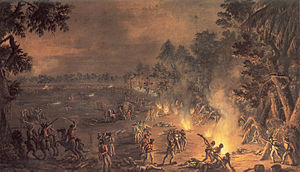
Back Battaglia di Paoli Italian パオリの戦い Japanese Paoli-massakren NB Bitwa pod Paoli Polish Бой при Паоли Russian Battle of Paoli SIMPLE
| Battle of Paoli | |||||||
|---|---|---|---|---|---|---|---|
| Part of the American Revolutionary War | |||||||
 A Dreadful scene of havock, a 1782 portrait depicting the Battle of Paoli | |||||||
| |||||||
| Belligerents | |||||||
|
|
| ||||||
| Commanders and leaders | |||||||
|
|
| ||||||
| Strength | |||||||
|
2,500 men
|
1,200 men engaged 600 in support 2 miles away | ||||||
| Casualties and losses | |||||||
|
201 killed or wounded[1] 71 captured [1] |
4 killed,[2] 7 wounded[2] | ||||||
Paoli Battlefield Site and Parade Grounds | |
 The Battle of Paoli monument in present-day Malvern, Pennsylvania | |
| Location | Roughly bounded by Warren, and Monument Aves. and Sugartown Rd., Malvern, Pennsylvania, U.S. |
|---|---|
| Coordinates | 40°01′47″N 75°31′06″W / 40.02972°N 75.51833°W |
| Area | 62.2 acres (25.2 ha) |
| Built | 1817, 1877 |
| Architect | John T. Windrim, Palmer C. Hughes |
| Architectural style | Colonial Revival, Late 19th and 20th century Revivals |
| NRHP reference No. | 97001248[3] |
| Added to NRHP | October 23, 1997 |
The Battle of Paoli, also known as the Battle of Paoli Tavern or the Paoli Massacre, was a battle in the Philadelphia campaign of the American Revolutionary War fought on September 20, 1777, in the area surrounding present-day Malvern, Pennsylvania. Following the Continental Army's retreat in the Battle of Brandywine and the aborted Battle of the Clouds, George Washington left a force behind under the command of Brigadier General Anthony Wayne to monitor and resist the British as they prepared to attack and occupy the revolutionary capital of Philadelphia.
On the evening of September 20, British forces under Major General Charles Grey led a surprise attack on Wayne's encampment near the Paoli Tavern in present-day Malvern, resulting in many American casualties. With inaccurate later claims that the British took no prisoners and granted no quarter, the engagement came to be known as the "Paoli Massacre."
- ^ a b McGuire p.146
- ^ a b McGuire p.132
- ^ "National Register Information System". National Register of Historic Places. National Park Service. July 9, 2010.
© MMXXIII Rich X Search. We shall prevail. All rights reserved. Rich X Search

